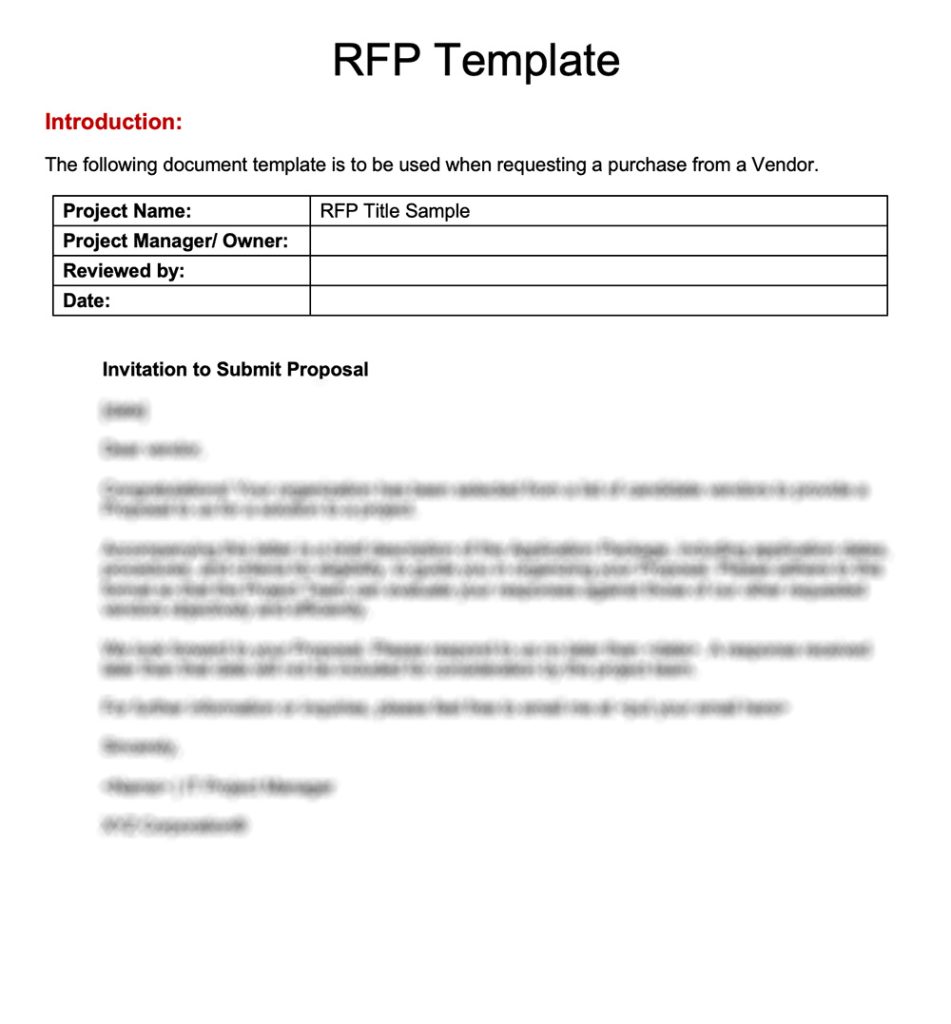A Request For Proposal (also known as a an RFP) is a document used by organizations to solicit services and bids from vendors. An RFP outlines the objectives of the planned project, the services and deliverables required by the organization, and any terms and conditions unique to the project. Vendors will then then analyze the RFP and submit their bids accordingly.

A well-written RFP can ensure that only the most qualified are among those who create a proposal for a project. Upfront transparency in the selection process, when combined with clear expectations can help both parties avoid misunderstandings and potential disappointment.
To help you create your RFPs more quickly, this template from the NOREX library features:
- An example introductory letter to invite proposals
- Project background and requirements
- Project needs and puposes
- Statement of work
- Space for estimated timelines
- Criteria for project evaluation
- Proposal formatting guidelines
- Proposal review checklist
To get access to this RFP template and thousands of other IT documents in our Resource Library, join NOREX today!
FREQUENTLY ASKED QUESTIONS
Why do companies or organizations use RFPs?
As an IT Leader, you use RFPs to find the best vendors for projects or services. RFPs help them gather competitive bids and evaluate proposals objectively. This process ensures transparency and fairness in vendor selection. RFPs also enable organizations to clearly outline their requirements, expectations, and evaluation criteria, ensuring that vendors understand what is needed. By soliciting proposals from multiple vendors, companies can compare offerings and negotiate terms to get the best value for their investment. Ultimately, RFPs streamline the procurement process and help organizations make informed decisions in selecting vendors.
What are the benefits of using an RFP for IT Services?
Using an RFP helps businesses find the best vendors or suppliers for their needs. It allows clear communication of requirements, ensuring vendors understand what’s needed. RFPs encourage competitive pricing as multiple vendors bid for the project, potentially lowering costs. They provide a structured way to evaluate vendors based on specific criteria, ensuring fair comparison. In addition, RFPs help mitigate risks by outlining expectations and responsibilities. Overall, using an RFP streamlines the vendor selection process, promotes transparency, and ultimately helps businesses make informed decisions that align with their goals and budget.
How does an RFP help in finding the right supplier or service provider?
An RFP helps in finding the right supplier or service provider by clearly stating what’s needed. It allows businesses to communicate their requirements effectively. With an RFP, multiple vendors can bid on the project, encouraging competitive pricing and ensuring options. It provides a structured way to evaluate vendors based on specific criteria, making comparison easier. By outlining expectations and responsibilities, RFPs help mitigate risks associated with choosing a supplier. Overall, using an RFP simplifies the vendor selection process, promotes transparency, and facilitates informed decision-making to find the best supplier or service provider.
Can you give examples of situations where an RFP would be useful?
An RFP would be valuable when a company needs to hire a vendor for a big project, like building a website or designing a new product. It’s also useful when a government agency wants to contract services for infrastructure development. In addition, RFPs are used in industries like construction, where companies need to bid on projects. Essentially, anytime a business or organization needs to gather competitive bids from potential suppliers or service providers, an RFP comes in handy.
What are some smart strategies for making the most of RFPs?
To make the most of RFPs…
- Clearly define project requirements to maximize RFP effectiveness.
- Provide detailed information to potential vendors for better understanding.
- Establish evaluation criteria beforehand for efficient proposal comparison.
- Invite bids from a diverse pool of vendors to ensure competitive pricing and innovative solutions.
- Set a realistic timeline for proposal submission and review to maintain efficiency.
- Foster open communication channels for vendors to ask questions and seek clarification.
- Consider holding pre-proposal meetings to address any uncertainties.
- Prioritize transparency and fairness throughout the RFP process.
- Select vendors based on their ability to meet project needs, rather than solely focusing on the lowest price.
Implementing these strategies streamlines RFP processes and leads to successful outcomes.
Using these resources properly can help your company thrive and gain new business. Being part of NOREX’s vendor-free IT community as a member can give you access to our extensive library of RFP templates and examples, plus a truly diverse collection of documents, resources and people that help our community — made by and for CIOs & IT leaders. Learn more just how beneficial being part of NOREX’s IT peer community really is.